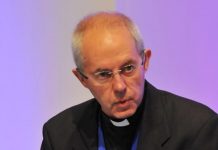Consecration and desecration are constants in the drama of sacred scripture. Time and again, the consecrated chosen people stray from their covenant, desecrating themselves by the worship of idols and foreign powers, returning to God after the consequences of their betrayal catch up with them and their eyes are opened by prophetic visions. In material, spatial terms, in tent cloth and stone, and in ritual terms, in incense and offering, this cycle is mirrored in the treatment of the sacred places, the altars and temples, which are despoiled and must be dedicated anew.
The meaning of sacred is that of being “set apart” for God, as the temple tent of the Lord in the desert was set apart from the main camp of the Israelites. When the everyday, that is, the profane, intrudes into the sacred, obscuring its purpose, a profanation or sacrilege has taken place.
The prophet Ezekiel in the Old Testament, and St. Stephen in the New, both summarize the rollercoaster peaks and troughs of profanation, purification, and rededication that the Jews and their temples ride down the centuries. Ezekiel’s account urges reconsecration in his own time, and it prefigures the ultimate profanation and purification that would come in Christ’s crucifixion, death, and resurrection. St. Stephen’s version acts as a preamble in his preaching to those who, magnifying the sacrilege of their forefathers, had destroyed the temple that was Christ’s body, which had been rebuilt in three days as He had foretold.
The role of elites and priests in inviting sacrilege is never far from the surface in these narratives. God grants Ezekiel a vision of King Solomon’s Temple just prior to its destruction, filled with reptilian and beastly idols by the very priests charged with its care, and in the holy of holies, the high priests worship not the God of Israel but the sun. God specifically condemns the conflation of the sacred and the profane:
Her priests have violated my law, and have profaned mine holy things: they have put no difference between the holy and profane, neither have they shewed difference between the unclean and the clean, and have hid their eyes from my sabbaths, and I am profaned among them. (Ezekiel 22:26 KJV)
St. Stephen’s uncompromising condemnation of the priestly class for their tragic repetition of their forebears’ sacrilege guaranteed him the reward of becoming the first martyr of the early Church, leapfrogging the original Apostles.
Carl Trueman has powerfully identified the desecration of man, as a lens through which to comprehend the bland form of chaos in which we all now live. He rightly identifies both sex and death as sacred features of man’s life, deserving of the reverence and rituals we have now cast aside, to our detriment. I would like to expand upon this and consider the desecration of the sacred ground of our temple buildings, as both a natural consequence of the desecration of ourselves—as fleshly temples stamped through with the Imago Dei—and as a contributing factor to that same desecration of man. For each form of profanation begets the other, in a self-destructive cycle reminiscent of an Ouroboros devouring itself.
The story of Canterbury Cathedral is instructive. It follows the pattern of Scripture in its peaks and troughs of reverence and corruption. Upon St. Augustine’s arrival in the pagan Kingdom of Kent and following the conversion of its king in 597, he committed an act of re-consecration following a previous desecration, discovering as he did the ruins of an older Roman church to use as the foundations for his cathedral. As Christianity came to dominate the island, the stature and glory of the cathedral grew.
In 1011 it was plundered and burned, and its Archbishop Aelfeah (better known now as St. Elphege) was slain by the pagan Viking raiders. This act of desecration by an external malevolent force ultimately served to increase the sacredness of the site in the long term, as the cult of Aelfeah as holy martyr developed. A fire in 1067 allowed a grander design to be enacted, much of which took place under the archbishopric of St. Anselm, famed for first proposing the ‘ontological argument’ for God’s existence. In 1170, moments after praying to his predecessor Aelfeah, St. Thomas Becket was slain, his brains spilled across the floor, for defending the Church’s rights from encroachment by the secular power. More than before, this act of brutal desecration—this time by Christian knights under the garbled orders of a Christian king—led to an ultimate re-consecration and sanctification of king, country, and cathedral.
With Henry VIII’s Reformation and sacking of the monasteries, the cathedral was plundered and desecrated in a more purposeful way than had come before. The venerated bones of a saintly Archbishop who had asserted the rights of the Church against the King could not be tolerated. The shrine was destroyed, along with the relics of St. Thomas. The enormously popular cult of Becket was suppressed. All the other canonized archbishops’ tombs were destroyed by 1541.
The cathedral faced further waves of desecration, such as the destruction of its sacred art by Cromwell’s puritans, who considered destroying the entire building for its ostentatious beauty and association with High Anglican practices. But alongside this, once the upheavals of the reformation calmed, efforts of re-consecration and rededication to the sacred were made. Though the monks were gone, the sacred music of Tallis and Byrd took the place of Gregorian chant and can be heard to this day in evensong, glorifying the Lord in this ancient temple. In place of the once magnificent shrine to St. Thomas in the Trinity Chapel, a lone candle burns where pilgrims gather once more. In recent years the celebration of Catholic Masses has been permitted again on special occasions in the cathedral precincts for some of those pilgrim groups which are slowly making their return.
This brings us to today, and the latest desecration in Canterbury, tying in so clearly with Trueman’s desecration of man, which we encounter all around in the all-dissolving soup of modernity. This February, the cathedral hosted an alcohol fuelled silent disco in its nave, to the music of the 1990s, ranging from popstar Britney Spears to rapper Eminem. The advertising imagery was clear: this was to be a purely profane event. In place of the cross, we have a DJ elevated with arms outstretched as if in mimicry, towering over the multitude of revellers, who though gathered together, each separately listen to their pop music via their own headphones, atomised by technology. “Strictly 18+” and “Stocked bar on site for the duration” stand out in the description of the event.
This is both alike and unlike other desecrations. Previous desecrations had other purposes: to plunder riches; to assert the power of the king; or to instil a supposedly purer, simpler form of worship. But this is something very different. Perhaps a desecration for the sake of desecration itself. As Trueman recently noted: “transgression is pleasurable, and the greater the transgression, the greater the pleasure. Well, there can be no greater transgression than that against the sacred.” Or, as the Marquis de Sade put it centuries before: “There is a kind of pleasure which comes from sacrilege or the profanation of the objects offered us for worship.”
Maybe we have already surpassed our ability to experience this pleasurable transgression. For to feel this transgression, one must have a sense of the sacrality of the sacred thing which is being desecrated. And it is not apparent that the average raver at these discos has that basic awareness. We might imagine that the cathedral structure itself conveys its sacredness, as centuries of prayer and worship have saturated the very stones of which it is made, which in turn breath out into the nave. But do they feel it in any serious sense? We are perhaps so far gone, as Theodore Dalrymple observed when exploring an old church that had been converted into a nightclub some years ago, that we are simply “barbarians inhabiting graceful ruins,” with no idea why those structures came into being, and no particular interest in understanding.
It is also important to note who the instigators of this desecration are. Not an external, hostile force, but the very priestly class charged with preserving and continuing the cathedral’s 15 centuries of sacred mission. They have acceded to the requests of a private company to use the holy ground as a quirky setting for a rave. The company is called “Silent Discos in Incredible Places,” but as the majority of their events appear to be held in ancient churches, perhaps a more alliterative rebrand to “Silent Discos in Sacred Places” would be more honest.
The business model is important to appreciate. The customers are not paying for the music, which they could listen to for free at home. Nor are they paying for the mere experience of attending a disco, “silent” or otherwise, which is offered by nightclubs the world over. They are paying for the unusual setting. They are paying for the fact that they will drink and dance to profane music in a place not meant for drinking and dancing to profane music.
The Canterbury disco sold out quickly, with tickets costing up to £50 for two and a half hours of transgression. On first hearing about the event, my brother and I and a few companions, having recovered after a some minutes of extreme vexation, made oaths to counter this sacrilege. These oaths, from time to time over the past months, we have regretted, for hopeless causes are as time consuming as realistic goals. What does it matter, that one more act of sacrilege is piled upon our culture in an old cathedral, many miles away?
But what did it matter to the Israelites, already demoralized, deep in the desert? What did it matter to Jerusalem, already steeped in idols, with the enemy at her gates? What did it matter to Jesus Christ, who saw his Father’s house become a den of robbers? But of course, those were different times, and we are not prophets.
Read it all in the European Conservative










